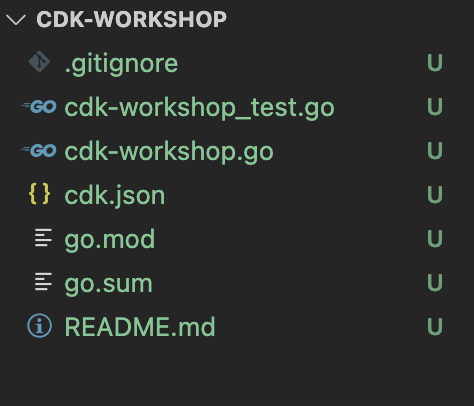Open your IDE #
Now’s a good time to open the project in your favorite IDE and explore.
If you use VSCode, you can just type
code .within the project directory.
Explore your project directory #
You’ll see something like this:

cdk-workshop.gois where your CDK application’s main stack is defined. This is the file we’ll be spending most of our time in. It also includes the entrypoint to the CDK applicationcdk-workshop_test.gocontains a sample test of the custom CDK stack created in the cdk_workshop package. This is mainly to demonstrate how tests can be hooked up to the project.cdk.jsontells the toolkit how to run your app. In our case it will be"go mod download && go run cdk-workshop.go"go.moddefines the module path as well as any dependencies necessary to make the application run. We shouldn’t need to touch this file during the workshop. (go.sumis an autogenerated file which locks the dependencies).gitignoretells git which files to include/exclude from source control.README.mdis the introductory README for this project. This is a text file that can be filled in to describe the project
Your app’s entry point and stack #
Let’s have a quick look at cdk-workshop.go:
package main
import (
"github.com/aws/aws-cdk-go/awscdk/v2"
"github.com/aws/aws-cdk-go/awscdk/v2/awssns"
"github.com/aws/aws-cdk-go/awscdk/v2/awssnssubscriptions"
"github.com/aws/aws-cdk-go/awscdk/v2/awssqs"
"github.com/aws/constructs-go/constructs/v10"
"github.com/aws/jsii-runtime-go"
)
type CdkWorkshopStackProps struct {
awscdk.StackProps
}
func NewCdkWorkshopStack(scope constructs.Construct, id string, props *CdkWorkshopStackProps) awscdk.Stack {
var sprops awscdk.StackProps
if props != nil {
sprops = props.StackProps
}
stack := awscdk.NewStack(scope, &id, &sprops)
queue := awssqs.NewQueue(stack, jsii.String("CdkWorkshopQueue"), &awssqs.QueueProps{
VisibilityTimeout: awscdk.Duration_Seconds(jsii.Number(300)),
})
topic := awssns.NewTopic(stack, jsii.String("CdkWorkshopTopic"), &awssns.TopicProps{})
topic.AddSubscription(awssnssubscriptions.NewSqsSubscription(queue, &awssnssubscriptions.SqsSubscriptionProps{}))
return stack
}
func main() {
defer jsii.Close()
app := awscdk.NewApp(nil)
NewCdkWorkshopStack(app, "CdkWorkshopStack", &CdkWorkshopStackProps{
awscdk.StackProps{
Env: env(),
},
})
app.Synth(nil)
}
// env determines the AWS environment (account+region) in which our stack is to
// be deployed. For more information see: https://docs.aws.amazon.com/cdk/latest/guide/environments.html
func env() *awscdk.Environment {
// If unspecified, this stack will be "environment-agnostic".
// Account/Region-dependent features and context lookups will not work, but a
// single synthesized template can be deployed anywhere.
//---------------------------------------------------------------------------
return nil
// Uncomment if you know exactly what account and region you want to deploy
// the stack to. This is the recommendation for production stacks.
//---------------------------------------------------------------------------
// return &awscdk.Environment{
// Account: jsii.String("123456789012"),
// Region: jsii.String("us-east-1"),
// }
// Uncomment to specialize this stack for the AWS Account and Region that are
// implied by the current CLI configuration. This is recommended for dev
// stacks.
//---------------------------------------------------------------------------
// return &awscdk.Environment{
// Account: jsii.String(os.Getenv("CDK_DEFAULT_ACCOUNT")),
// Region: jsii.String(os.Getenv("CDK_DEFAULT_REGION")),
// }
}
First, this code declares the NewCdkWorkshopStack class. This stack
contains the infrastructure that we want to deploy. The stack includes:
- SQS Queue (
sqs.Queue) - SNS Topic (
sns.Topic) - Subscribes the queue to receive any messages published to the topic (
topic.AddSubscription)
Next, in main() the code creates an app and defines an instance of the NewCdkWorkshopStack
within the scope of the app. This will allow the stack to be synthesized and deployed. A null
value is passed in for the environment of the stack - that’s okay for the purposes of the workshop
since the account and region to deploy to will be inferred through your credentials.